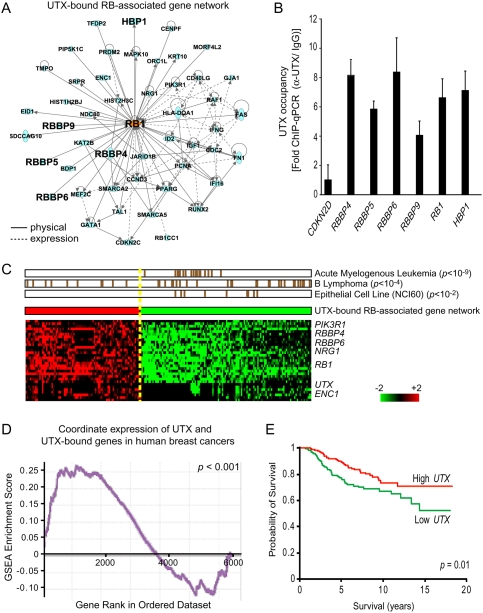Figure 2.
UTX regulates many RB-binding proteins, which are coordinately decreased in expression in human cancers. (A) Top network of genes occupied by UTX organized by Ingenuity Pathway Analysis. (Center) Forty-nine UTX-occupied genes are known to be associated with RB. The solid line indicates known physical interaction, while the dashed line indicates known interaction by regulation of expression. Genes of special interest are in large font. (B) Validation of UTX occupancy of RB pathway genes by ChIP-qPCR. CDKN2D is not a UTX target gene and served as negative control. (C) The UTX–RB gene network is coordinately repressed in human cancers. We interrogated a compendium of 1973 microarrays representing 22 human tumor types and diverse normal controls for coordinate regulation of the genes occupied by UTX. In the bottom matrix, each column is a sample showing significant coordinate induction (red) or repression (green) of UTX network genes (P < 0.05, FDR < 0.05); each row is a UTX network gene. The middle bar shows the average level of activity of the UTX–RB network in each sample. The top matrix displays whether the coordinate induction or repression of UTX–RB network is enriched for specific clinical annotations. Each brown hatch mark indicates a sample with the indicated annotation; each row is an enriched annotation (P < 0.05, FDR < 0.05, hypergeometric distribution) that shows selective deactivation of the network in cancers relative to their normal counterparts. (D) RB pathway gene expression is correlated with UTX. Genes are sorted and ranked based on Pearson correlation to UTX. Gene set enrichment analysis of the Pearson correlation of UTX-bound genes in 295 human breast cancer patients shows that UTX-bound genes are significantly positively correlated with UTX expression (P < 0.001). (E) UTX expression level is a predictor of patient survival. Kaplan-Meier analysis of patients with high versus low UTX expression is shown for the 295 breast cancer patients (160 patients have “high” UTX expression; 135 patients have “low” UTX expression).

